
R Horologii is a red giant star approximately 760 light-years away in the southern constellation of Horologium. It is a Mira variable with a period of 404.83 days, ranging from apparent magnitude 4.7 to 14.3—one of the largest ranges in brightness known of stars in the night sky visible to the unaided eye. The star is losing mass at the rate of 5.9×10−7 M☉·y−1.
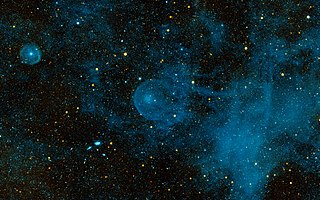
CW Leonis or IRC +10216 is a variable carbon star that is embedded in a thick dust envelope. It was first discovered in 1969 by a group of astronomers led by Eric Becklin, based upon infrared observations made with the 62-inch Caltech Infrared Telescope at Mount Wilson Observatory. Its energy is emitted mostly at infrared wavelengths. At a wavelength of 5 μm, it was found to have the highest flux of any object outside the Solar System.

T Cephei is a Mira variable star in the constellation Cepheus. Located approximately 600 light-years distant, it varies between magnitudes 5.2 and 11.3 over a period of around 388 days.
Propynylidyne is a chemical compound that has been identified in interstellar space.
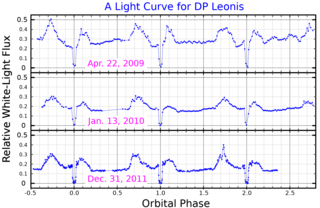
DP Leonis is a binary star system in the equatorial constellation of Leo. It is a variable star that ranges in apparent visual magnitude from 17.5 down to 19. The system is located at a distance of approximately 990 light-years from the Sun based on parallax. It is a cataclysmic variable star of the AM Herculis-type also known as polars. The system comprises an eclipsing white dwarf and red dwarf in tight orbit and an extrasolar planet. This eclipsing variable was discovered by P. Biermann and associates in 1982 as the optical counterpart to the EINSTEIN X-ray source E1114+182.
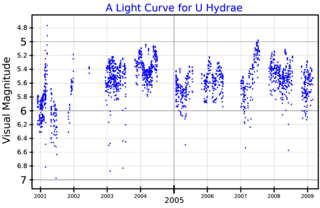
U Hydrae is a single star in the equatorial constellation of Hydra, near the northern constellation border with Sextans. It is a semiregular variable star of sub-type SRb, with its brightness ranging from visual magnitude (V) 4.7 to 5.2 over a 450-day period, with some irregularity. This object is located at a distance of approximately 680 light years from the Sun based on parallax. It is drifting closer with a radial velocity of −26 km/s.

HD 165634 is a star in the southern constellation of Sagittarius. It has a yellow hue and is faintly visible to the naked eye with apparent visual magnitude of 4.56. The star is located at a distance of approximately 339 light years from the Sun based on parallax, but is drifting closer with a radial velocity of −5 km/s. It has an absolute magnitude of −0.53.
69 Virginis is a single star in the zodiac constellation of Virgo, located about 259 light years away. It is visible to the naked eye as a faint orange-hued star with an apparent visual magnitude of 4.76, although it is a suspected variable that may range in magnitude from 4.75 down to 4.79. This object is moving closer to the Earth with a heliocentric radial velocity of −13 km/s. The light from this star is polarized due to intervening interstellar dust.

GJ 1151 is a star located in the northern circumpolar constellation of Ursa Major at a distance of 26.2 light-years from the Sun. It has a reddish hue and is too faint to be visible to the naked eye with an apparent visual magnitude of 14.0 The star is moving closer with a radial velocity of −36 km/s, and has a relatively large proper motion, traversing the celestial sphere at a rate of 1.815″·yr−1.
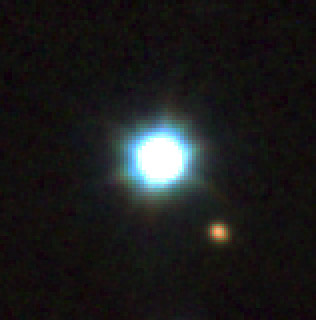
VHS J125601.92–125723.9 is a young triple brown dwarf system located in the constellation Corvus approximately 69.0 light-years from the Sun. The system consists of the equal-mass binary VHS J1256–1257AB and the distant planetary-mass companion VHS 1256–1257 b. In 2022, a continuous radio emission from the radiation belts surrounding VHS J1256–1257 was detected.
HD 126053 is the Henry Draper Catalogue designation for a star in the equatorial constellation of Virgo. It has an apparent magnitude of 6.25, which means it is faintly visible to the naked eye. According to the Bortle scale, it requires dark suburban or rural skies to view. Parallax measurements made by the Hipparcos spacecraft provide an estimated distance of 57 light years to this star. It is drifting closer with a heliocentric radial velocity of −19.2 km/s.
Tricarbon monosulfide (C3S) or tricarbon sulfur is a reactive molecular substance that has been detected in outer space. Tricarbon monosulfide is a heterocumulene or thiocumulene, consisting of a straight chain of three carbon atoms and a terminal sulfur atom.

A circumplanetary disk is a torus, pancake or ring-shaped accumulation of matter composed of gas, dust, planetesimals, asteroids or collision fragments in orbit around a planet. They are reservoirs of material out of which moons may form. Such a disk can manifest itself in various ways.
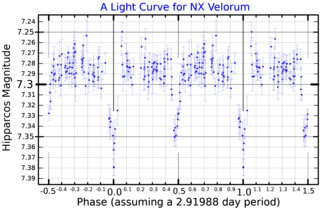
HD 73882 is a visual binary system with the components separated by 0.6″ and a combined spectral class of O8. One of stars is an eclipsing binary system. The period of variability is listed as both 2.9199 days and 20.6 days, possibly due to the secondary being a spectroscopic binary star.
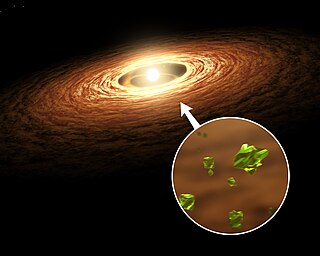
EX Lupi is a young, single T-Tauri star in the southern constellation of Lupus. An irregular variable, it is the prototype of young, low-mass eruptive stars named EXors, with EX Lupi being this object's variable star designation. At its minimal activity level, EX Lupi resembles a classical T-Tauri star of the M0 dwarf type. The low latitude of this star, at a declination of −40°, makes it difficult for northern observers to view. Based on parallax measurements, it is located at a distance of about 505 light years from the Sun. The star lies next to a gap in the Lupus cloud complex, a star forming region.
HD 210056, also known as HR 8432, is a solitary orange hued star located in the southern circumpolar constellation Octans. Eggen (1993) listed it as a member of the old disk population.
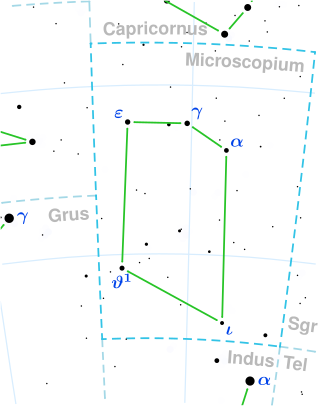
HD 196737, also designated as HR 7893, is a solitary orange hued star located in the southern constellation Microscopium. It has an apparent magnitude of 5.47, allowing it to be faintly visible to the naked eye. The object is located relatively close at a distance of 241 light years based on Gaia DR3 parallax measurements, but is receding with a heliocentric radial velocity of 14.2 km/s. At its current distance, HD 196737's brightness is diminished by 0.14 magnitudes due to interstellar dust. It has an absolute magnitude of 1.17.





























